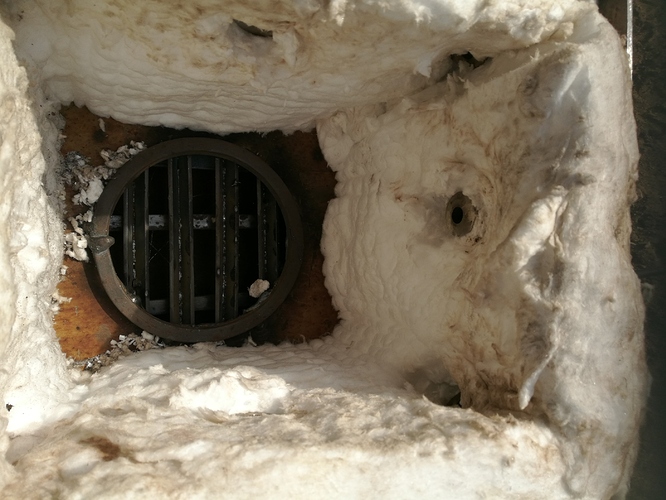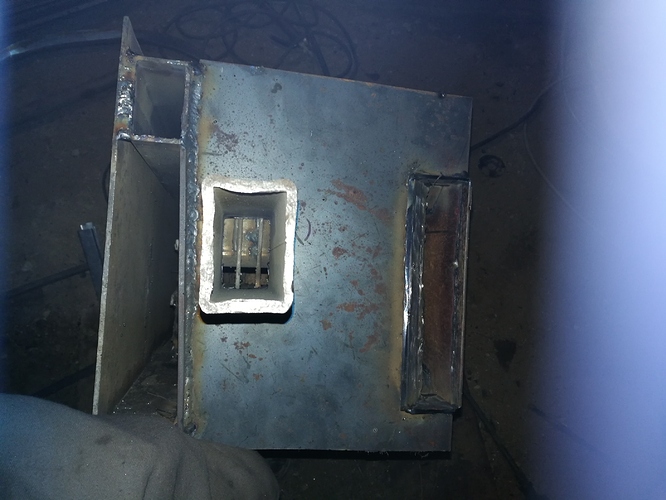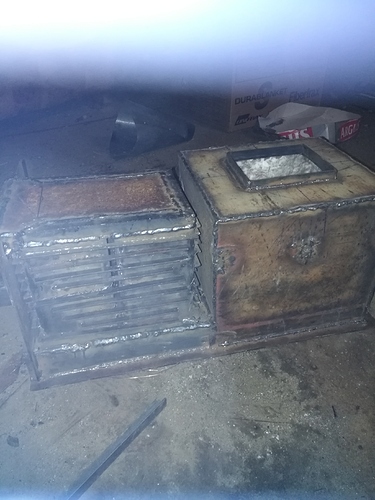If your nozzles are put high enough in your fire (tube) box the incoming charcoal at 60 * slope might not actually touch the nozzles keeping them safe from the hot white charcoal. May be using ceramic wool in this area would help around the nozzles. Not sure how you would hold it in place. If you think the bottom of the fire box needs protection from the white hot charcoal at the reduction zone it could be placed there. Heat does and can go though ceramic wool, it is used more for the protection of metals in really white hot areas that would destroy other glass insulations.
Bob
From what i noticed on units that have come into the yard that are lined with this material and from what we have been told by the company that fabricated that large stainless steel oven, is that they use a high temp glue to hold the Kwool onto the walls ,floor and ceiling and once the oven is fired up and has been used the Kwool goes hard almost like a board and then just sits in place , but will flake and break off in lumps if hit or banged against .
Dave
Bob, the firebox (l like the name btw) is made wk style with air mantel around so no worrys as the heat escaped trugh insulation will be recaptured in intake air.
I was thinking to insulate the whole firebox on inside walls so that only the nozzles stick out. The purpose of the insulation is most of all fast startup time, wery important in my case.
Dave, first time l hear of a high temp glue?
This is just one type Heat Resistant Rope Seal Adhesive White for Gluing Seals | VITCAS
very cheap in the uk , here a small bottle of the stuff costs $30 at the local wood stove store . this is another type i think
https://www.amazon.co.uk/STOVE-ROPE-BOND-HIGH-ADHESIVE/dp/B0073EPM5E
Yes, and also my S10
Bulb planter?? I guess I must be getting old - I can’t remember that. I had this spiral auger from the beginning with the wood burning Tracker.
Ha, drilling those ss rods must have been a full days work 
About the inside high temp insulation. With those nozzle lengths, wouldn’t a pretty good ash cone form? With or without the insulation I can’t imagine a difference in startup time would be even possible to detect. Also if the blanket needs any attention before it settles it would be a pita to get to it with your hopper design.
I agree with JO on the start up time and the ash cone. If I remember correctly you had problems with using ceramic wool in your last unit. If the ash will work just use it, less hassle to deal with especially with your set up of no access through the hopper or grate. Make it so you do not have to go back into it to fix something. Ceramic wool is hard to work with in my opinion.
Bob
Hi Kristijan,
a lot was going on in a few days. Again I’m very impressed by your building speed!
Your model really looks quite compact, but should be large enough compared to other charcoal gasifiers.
My thoughts to wetting the charcoal and the auger:
It should be moist and not wet. If its too wet, water may collect at the bottom of the hopper and flood the gasifier. This could lead to lighting problems.
Also, if the char is too wet the dust will tend to stick together in corners, and it could cause a kind of bridging, especially where it should fall through the hopper constiction.
The auger: How do you will control the speed of it? I’m afraid the it could grind down the char to dust if it is on permanently or with too high speeds.
Don asked about clinker. I think the same as Kristijan. First, water or steam should cool down the reaction zone so that no clinker or just very little is formed. Ash an clinker move down with the consumed char to the grate. Here it can be ground with grate motion.
In the Swedish book it is written about the Mako gasifier, that it required little maintenance. As this gasifier here is very similar, we can be optimistic.
Clinker formation on the grate was also a big problem with steam locomotives. In late advanced locos, so called “clinker control steam” was introduced in the ashpan to cool the grate and the ashes/clinker on the grate. It also made the clinker more crumbly.
In a charcoal gasifier, the “sweet spot” with steam addition will give a reaction temp of 800 to 1000 degree Celsius. At this temp, not much clinker will form.
Til
I thod so too but l belted the drill press real slow and used a high quality drill with lots of lubricant l was done in no time.
JO and Bob,
The thing is nozzles are ~8" apart, nozzle height 6.5" and restriction dia 6.5". Its just too vertical for a ash cone. I will try my luck with the wool, since l already ordered it. I can bust it out somehow if it doesent work.
I will try to burn the blanket in before l seal the gasifier. I have a couple of chisels to forge 
Til, l just checked my charcoal soaking experiment, the most water char can absorb without being driping wet is 140g water on 100g charcoal. Well my ming is blown, charcoal is just amazing.
Anyway, l am not afraid of water driping from char, but condensation is possible! I do hope to let some air in the hopper to keep it gas free (part of the reason l want a hopper restriction) but no idea how this will work.
Good thinking on wet char dust “3D printing” its self on gasifier components! I hope once enough acumulates, it wuld vrake off…
Do you maybee have any measurments on the Mako junior gasifier? For a normal Mako there are mesurments in the Swedish book but not on its smaller brother…
Thank you for very usefull information
Rindert
Hi Kristijan,
I’m sorry, the onlything I know about the Mako is from the book. I searched the internet but haven’t found something else.
Rindert, you are welcome!
At this temp, the richest gas (highest heating value) is made. Keep in mind, the better the heat economy of the system, the more steam can be added to get the same temp, the richer the gas.
This is in regards to ceramic blankets; never use without a rigidizer or a sealed enclosure. The idea is to keep all fibers out of your environment/air-supply. You do not want these fibers to end up in one of your filters that you would be exposed to while cleaning.
Yes Kristijan burn the ceramic blanket in good forming a harding crust to make it stay put. I like the glue idea. Just above my 2" nozzle in my charcoal unit on the hopper wall I used 3M spray can adhesive contack glue on my ceramic wool blanket and the hopper wall. With all the heat and charcoal moving by it is still stuck to the hopper wall. It would not have stayed in place with out the glue holding it there in place. On the can it did not mention anything about high heat resistance. But it still worked find so far.
Bob
“Keep in mind, the better the heat economy of the system, the more steam can be added to get the same temp, the richer the gas.”
Til, have you red trugh recent Bobs 92 Dakota thread? We talked a lot about that exact thing there!
Bob, rigidiser? I asked the dealer if it needs anything else at instalation and she said no. The firm makes industrial kilns and electro ovens so l guess she is to be trusted? I will ask again when l pick up the wool.
I was going to use this, but I was doing my build in the winter, and it can not freeze. So they won’t ship in cold weather. https://www.ebay.com/itm/1-Quart-Silica-Sol-Inorganic-Binder-Rigidizer-For-Ceramic-Fiber-Blanket/222866476098?hash=item33e3e08c42:g:35gAAOSwrBVam-OL:rk:1:pf:1&frcectupt=true
Isn’t that just more or less hydrated silica or silicic acid? Or does that have waterglass in it?
Waterglass (sodium silicate or sodium polysilicate) hardens fast (uses CO2 to harden). It is used for cement floor coatings. and mixed with sand for castings. It might be a better option.
I asked at the company selling the cheramic wool, and they do have rigidiser on stock. The price is astronomical and they only sell 5gal+ quantity but l did get a product specification sheet. Ha! Im preety sure its water glass. The higher grades have some aluminium “oxide” in them. I will make my own mix. I have waterglass at home and l can make aluminium hydroxide from foil disolved in lye. When it burns to high temps it turns to aluminizm oxide.
Water glass is sodium silicate. It will make it more rigid but it will melt at around 1100C.
Sean, yes, but l bet the secret is in aluminium oxide. Together they form aluminium silicate wich is allso the composition of cheramic wool.
Todays progress
One major change to the design. I decided not to install the filter sacs. The finned thing on the pic is a dropbox/heat exchanger combo


